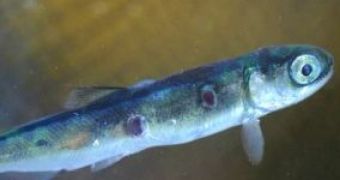A new study has found that wild salmon fry moving downstream toward the sea are being killed en route by sea lice, a parasitic crustacean, from salmon fish farms.
The losses range from 9 percent in the early spring, when parasite populations are low, to 95 percent in late spring, when the parasites are at their peak, forming dense clouds that salmon fry have to swim through. "Even the best case scenario - 9% or 10% on top of the normal high mortality in the life of a juvenile salmon - is pretty scary," says John Volpe at the University of Victoria, British Columbia, Canada.
"We often worry about wildlife making humans sick, but here is a case where humans are making wildlife sick," said Mark Lewis of the University of Alberta, Canada.
After tumbling onto their hosts, the crustaceans dig into the flesh, creating open wounds that make the young salmon more vulnerable to predators and infection. Due to their large mass (up to 125 pounds) and scales, adult salmon are better protected against these crustaceans and can hold the parasite without being severely affected.
Salmon fries, meanwhile, are about an inch long, weigh only about half a gram and are scaleless.
In nature, juvenile salmon do not encounter adults during the first few months of their live, because adults live far out at sea and they migrate from rivers downstream to the sea. Salmon farms break down that ecological separation, and this may have contributed to the decline of wild populations.
Scientists found that the salmon were rarely infested by sea lice before they reached the first fish farm, after which infestation levels increased sharply. "All it takes is one or two lice to kill one of these juvenile fishes," said Martin Krkosek, of the University of Alberta.
"The lice can literally feed on the fish faster than it can feed itself and the fish starves to death."
"By situating along natural salmon migration routes, aquafarms are interfering with the natural life cycles of the wild salmon, Krkosek said. Normally, adult salmons are far offshore when the juveniles are migrating to sea, and the two groups don't meet for several months."
"That's when the parasites get transferred from generation to generation".
"But at that point, the juveniles are much larger and have scales."
"Other sea fish that are now being farmed, such as halibut and sablefish, have a similar habitat separation between juveniles and adults, so fish farming may have similar impacts on their wild populations," says Volpe.

 14 DAY TRIAL //
14 DAY TRIAL //